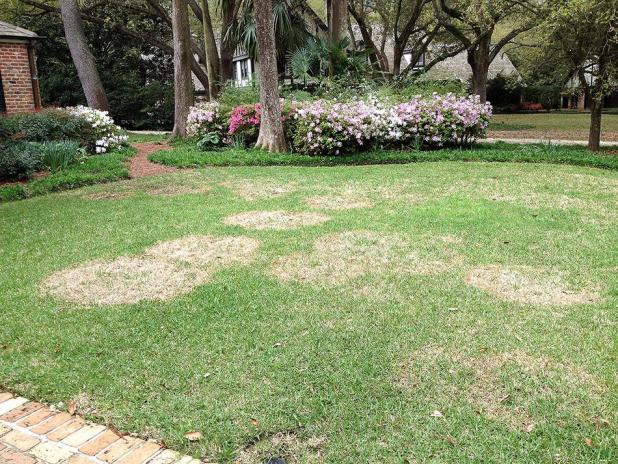
A St. Augustine lawn is severely infected with large patch disease.
—LSU AgCenter/Raj Singh
Large patch disease increases in La. lawns
BATON ROUGE — Large patch disease (formerly called brown patch) is the starting to show up in Louisiana lawns.
LSU AgCenter plant doctor Raj Singh said this fungus is the most common disease of lawns in Louisiana.
The disease can occur on all warm-season turfgrasses but is particularly prevalent on St. Augustine grass.
“Symptoms appear as yellow, circular or irregular-shaped patches of disease that can become quite extensive,” Singh said. “As the disease develops, large areas of turf appear brown as smaller patches come together.”
The pathogen does not kill the grass but rather causes a rot at the base of the leaf sheaths, resulting in easy separation of leaves from the crown of the plant.
Large patch is caused by the soil-borne fungus Rhizoctonia solani. Optimal conditions for disease development occur when nighttime temperatures range from 60-75 degrees and daytime temperatures do not exceed 85-90 degrees.
“Free water, from irrigation nor dew, on foliage is required for disease to develop,” he said. “The disease spreads rapidly on lawns with poor air circulation.”
One way to reduce disease incidence and accelerate turfgrass recovery is to maintain a healthy lawn through balanced fertilization and irrigation, and regular mowing.
“Never apply more than 1 pound of nitrogen per 1,000 square feet for an application, and always follow soil test recommendations for proper fertility,” Singh said.
Large patch symptoms are exacerbated with excess nitrogen. Slow-release fertilizers with a balanced amount of nitrogen and potassium are recommended.
Irrigate lawns as early as possible in the morning while taking rainfall into account.
“Water deeply and as infrequently as possible without causing drought stress,” Singh said. “Improve internal soil drainage and reduce compaction by aerating the lawn regularly.”
Minimize the amount of shade and improve air circulation over the lawn.
Raising mowing height will help the turfgrass to recover. Do not mow lawns when wet, and mow diseased areas last because disease may spread to healthy areas with infected grass clippings.
Cleaning lawn mowers to remove grass clippings may help reduce the spread of the disease.
“Excessive thatch can negatively affect turfgrass growth and provide a suitable environment for the pathogen,” Singh said. “Dethatching may be necessary to improve turfgrass growth.”
In addition to cultural practices, fungicide applications may be required to achieve effective disease management.
When using fungicides, always remember to follow the label rates and frequency of application.
Fungicides containing an active ingredient such as azoxystrobin, myclobutanil, propiconazole or triadimefon may be used to manage large patch.For diagnostic help with lawn problems, contact the LSU AgCenter Plant Diagnostic Center at 225-578-4562 or email Singh at rsingh@agcen ter.lsu.edu.
